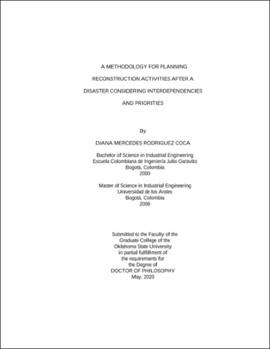| dc.contributor.advisor | Kamath, Manjunath | |
| dc.contributor.author | Rodriguez Coca, Diana Mercedes | |
| dc.date.accessioned | 2020-09-09T20:49:16Z | |
| dc.date.available | 2020-09-09T20:49:16Z | |
| dc.date.issued | 2020-05 | |
| dc.identifier.uri | https://hdl.handle.net/11244/325447 | |
| dc.description.abstract | A disaster relief chain can be divided into phases such as pre-disaster, disaster response, and post-disaster. This paper focus on the post-disaster phase, specifically in the recovery activity. After a disaster occurs, the road infrastructure gets compromised as roads can be damaged or blocked by debris. This situation represents a threat for the people affected by the disaster because it severely impacts their accessibility to vital locations such as hospitals, police stations, and fire stations. For efficient planning of reconstruction activities, we develop a two-stage methodology employing Steiner Tree and scheduling algorithms that incorporate the principal characteristics of the real-world situation. The objective was to minimize the total completion time to restore access to essential facilities. The mathematical modeling approach identifies the roads that need to be restored considering dynamic resources, priorities, and interdependencies among the essential facilities that need to be connected. In addition, the optimal schedule for restoring the roads, including the crews' assignment is provided. Considering these aspects in the overall methodology were some of the key challenges that our study has addressed. Hazus, a tool developed by the Federal Emergency Management Agency (FEMA) was used to obtain the data related to the impact of a disaster on facilities and transportation network. We replicated the 1994 Northridge Earthquake to test the applicability of our methodology and models under multiple scenarios. | |
| dc.format | application/pdf | |
| dc.language | en_US | |
| dc.rights | Copyright is held by the author who has granted the Oklahoma State University Library the non-exclusive right to share this material in its institutional repository. Contact Digital Library Services at lib-dls@okstate.edu or 405-744-9161 for the permission policy on the use, reproduction or distribution of this material. | |
| dc.title | Methodology for planning reconstruction activities after a disaster considering interdependencies and priorities | |
| dc.contributor.committeeMember | Ingalls, Ricki | |
| dc.contributor.committeeMember | Balasundaram, Balabhaskar | |
| dc.contributor.committeeMember | Delen, Dursun | |
| osu.filename | RodriguezCoca_okstate_0664D_16636.pdf | |
| osu.accesstype | Open Access | |
| dc.type.genre | Dissertation | |
| dc.type.material | Text | |
| dc.subject.keywords | disaster | |
| dc.subject.keywords | network design | |
| dc.subject.keywords | reconstruction | |
| dc.subject.keywords | scheduling | |
| thesis.degree.discipline | Industrial Engineering and Management | |
| thesis.degree.grantor | Oklahoma State University | |
